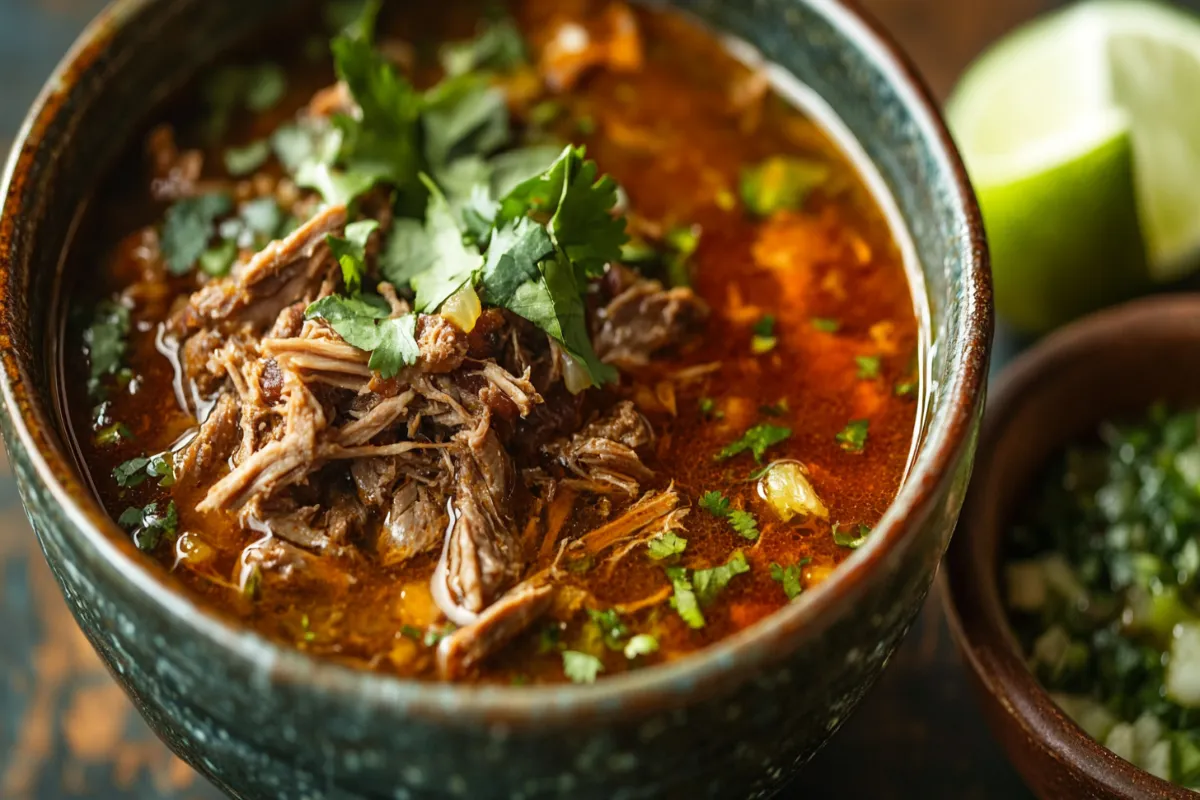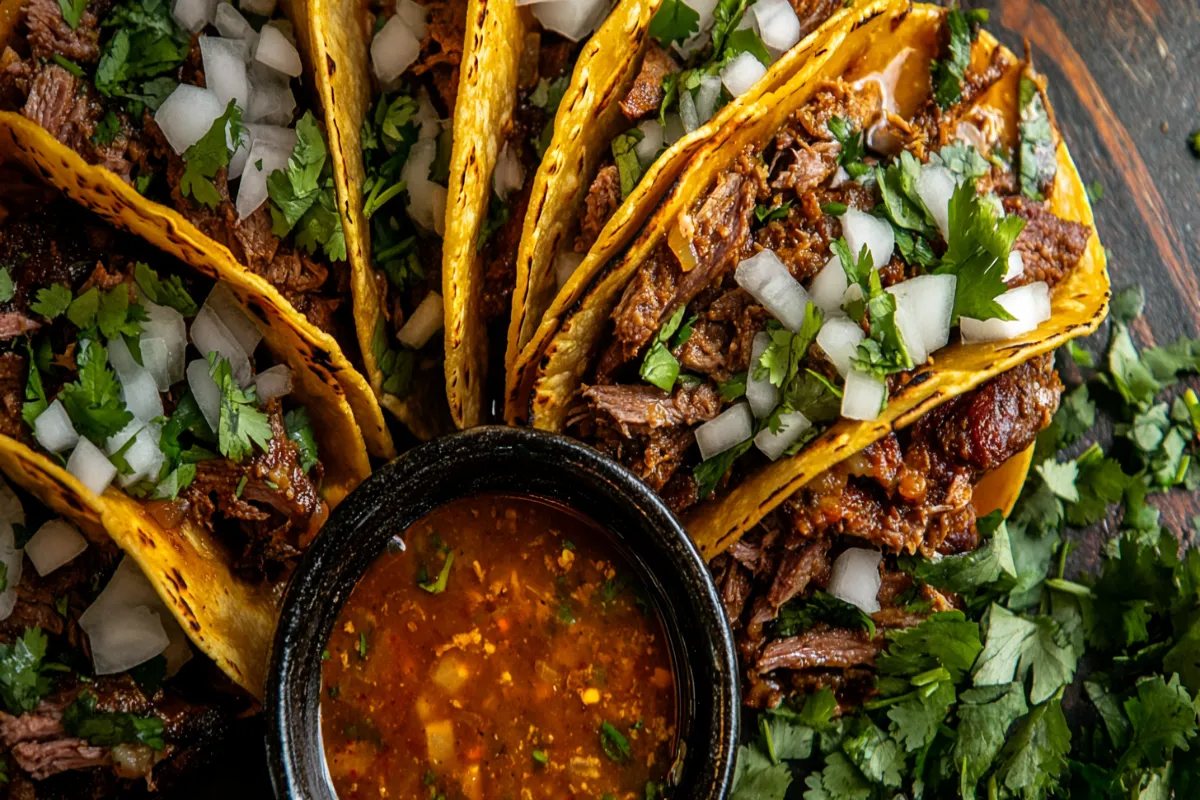Table of content
- Introduction
- History and Background
- What Is Birria Made Of?
- Health Benefits of Birria
- How to Make Birria: Step-by-Step Guide
- Birria Variations and Customizations
- Pairings and Serving Suggestions
- Frequently Asked Questions (FAQs)
- Conclusion
Introduction
Birria is a mouthwatering Mexican dish that has taken the culinary world by storm. Known for its rich, hearty flavors and tender meat, birria is a favorite at family gatherings, restaurants, and street food stands alike. Whether you’re enjoying it as a stew or in the form of birria tacos, this dish offers a unique combination of spices and slow-cooked goodness that sets it apart. But what exactly is birria made of? In this article, we’ll dive deep into the traditional ingredients, explore modern variations, and guide you through the process of making this beloved dish at home.
History and Background
Birria originated in the state of Jalisco, Mexico, during the colonial period. It was initially developed as a way to make goat meat more palatable, as the animal had been introduced to the region by the Spanish but was considered too tough and gamey by many locals. By marinating the meat in a flavorful mixture of spices and slow-cooking it, people were able to create a tender, savory dish that quickly became popular.
Over time, birria evolved into a dish that was celebrated for special occasions and festive gatherings. While goat remains the traditional meat used, today you’ll often find beef birria or other meat variations across Mexico and the U.S., especially in birria tacos, which have become a sensation in recent years.

What Is Birria Made Of?
Birria’s key to success lies in its flavorful ingredients and slow-cooking process. Here’s a breakdown of what goes into making this dish.
1. Main Ingredients
- Meat: Traditionally, birria is made with goat (specifically a young goat called “chivo”), but beef has become increasingly common, particularly in the U.S. Lamb, mutton, and even chicken can also be used. The key is to use a cut of meat that benefits from slow cooking, allowing it to become tender over time.
- Chilies: Dried chilies are essential for the sauce, also known as “adobo.” Common varieties include:
- Guajillo chilies: Mild with a sweet flavor
- Ancho chilies: Rich and smoky
- Chipotle chilies: For a bit of heat and smokiness
- Spices and Herbs: The adobo is heavily seasoned with a mixture of spices, such as:
- Cumin
- Oregano (preferably Mexican oregano)
- Cloves
- Cinnamon
- Bay leaves
- Black pepper
- Acidic Components: Vinegar, tomatoes, or tomatillos are used to balance the rich, meaty flavors with a tangy contrast.
- Garlic and Onions: These aromatics add depth to the sauce.
2. Modern Variations
In recent years, birria has evolved beyond its traditional preparation, embracing a variety of modern twists to cater to diverse tastes and regional preferences. While the traditional recipe typically calls for ingredients like goat or lamb, today’s birria often includes additional elements that both enhance the flavor and introduce new textures. Whether you’re looking to experiment with the flavors or adapt the dish to meet dietary preferences, there are plenty of exciting ways to modernize this classic Mexican dish.
Here are some popular modern variations:
Beef Broth or Stock:
Traditional birria recipes use the drippings from slow-cooked meat, but modern versions often call for beef broth or stock to add a richer depth of flavor. This ingredient provides an extra umami boost, making the dish even more savory. For those who don’t have access to the original cooking liquid, beef broth serves as a convenient and flavorful substitute.
Additional Spices:
While traditional birria is already packed with aromatic spices like cumin and oregano, some modern recipes incorporate paprika, coriander, or even smoked chipotle for an extra layer of complexity. These spices provide a smokier, earthier flavor profile and can transform the dish into something that feels both familiar and new.
Halal-Friendly Substitutions
In many modern halal adaptations, beer—which is sometimes used in non-halal versions to tenderize the meat and add subtle bitterness—can easily be replaced with stock or water. This not only keeps the dish in line with halal dietary guidelines but also maintains the depth of flavor without the use of alcohol. Some cooks also experiment with apple cider vinegar or kombucha as alternative ingredients to achieve a similar tangy note.
Vegetable Additions
Although birria is traditionally a meat-centric dish, some modern versions have started incorporating vegetables for added texture and flavor. Carrots, potatoes, and zucchini are commonly added to the stew, contributing heartiness and slight sweetness that balance out the savory meat and bold spices. These vegetables also absorb the rich broth, enhancing their flavor and making the dish more substantial.
Vegan and Vegetarian Birria
As plant-based diets grow in popularity, some chefs and home cooks have developed vegan and vegetarian versions of birria. Instead of meat, they use hearty vegetables like mushrooms, jackfruit, or plant-based protein substitutes to mimic the texture and richness of traditional birria. The spices and broth remain the same, ensuring that even without meat, the dish retains its bold, comforting flavor.
Cheese-Stuffed Birria Tacos
Another trendy adaptation is birria tacos stuffed with melty cheese, known as quesabirria. This modern twist involves filling tortillas with birria meat and cheese, then frying them on a griddle until crispy. These tacos are often served with a side of the rich broth for dipping, creating a flavor-packed, indulgent experience.
Birria Ramen
For a fusion twist, birria ramen has gained popularity in some areas, combining the robust flavors of birria with the comfort of a classic noodle soup. In this dish, the birria broth is used as the ramen base, and the meat is added on top of the noodles. The result is a delightful blend of Mexican and Japanese cuisine that’s both comforting and excitingly new.
These modern variations allow for plenty of creativity while still maintaining the essence of birria’s rich, flavorful tradition. Whether you’re sticking to halal-friendly ingredients or experimenting with bold new flavors, the versatility of birria ensures that it can be adapted to suit a wide range of tastes and preferences.
Health Benefits of Birria
Birria can be a nutritious dish, especially when made with lean cuts of meat like goat or chicken. Here’s a look at its health benefits:
- Rich in Protein: Meat is the primary ingredient, offering a high-protein content that supports muscle repair and growth.
- Source of Essential Nutrients: The chilies and spices in birria provide antioxidants, while the meat offers important nutrients like iron, zinc, and B vitamins.
- Low Carb: Birria, in its stew form, is naturally low in carbohydrates, making it a suitable option for those following low-carb or ketogenic diets.
- Customizable for Health Needs: By choosing leaner cuts of meat or adjusting the spice levels, you can make birria that fits your dietary preferences without sacrificing flavor.
How to Make Birria: Step-by-Step Guide
Ingredients:
- 2 pounds of goat, beef, or lamb (with bones)
- 3 dried guajillo chilies
- 2 dried ancho chilies
- 1 dried chipotle chili
- 1 onion, chopped
- 5 garlic cloves, minced
- 2 tomatoes or 1 cup of tomato puree
- 1 tablespoon vinegar
- 1 teaspoon ground cumin
- 1 teaspoon dried oregano
- 1/4 teaspoon ground cinnamon
- 2 bay leaves
- Salt and pepper to taste
- Water or broth as needed
Instructions:
- Prepare the Chilies: Start by removing the stems and seeds from the dried chilies. Toast them lightly in a dry pan for about 1-2 minutes to bring out their flavor.
- Soak the Chilies: Place the toasted chilies in a bowl and cover them with hot water. Let them soak for 20 minutes until they soften.
- Make the Adobo Sauce: In a blender, combine the soaked chilies, tomatoes, garlic, vinegar, cumin, oregano, cinnamon, and a pinch of salt. Blend until smooth.
- Marinate the Meat: Place your meat in a large bowl and cover it with the adobo sauce. Allow it to marinate for at least 2 hours or overnight for best results.
- Cook the Birria:
- Stovetop Method: Place the marinated meat and sauce in a large pot, add water or broth to cover, and simmer on low heat for 3-4 hours until the meat is tender and falls apart.
- Slow Cooker Method: Transfer the marinated meat and sauce to a slow cooker, add broth, and cook on low for 6-8 hours.
- Shred the Meat: Once the meat is fully cooked, remove it from the pot and shred it with a fork. Return the shredded meat to the sauce to absorb more flavor.
- Serve: Traditionally, birria is served in a bowl with broth, garnished with chopped onions, cilantro, and a squeeze of lime. You can also enjoy it in tacos or quesabirria style (with cheese).

Birria Variations and Customizations
- Beef Birria: As a popular alternative to goat, beef (often chuck roast or short ribs) is commonly used for its availability and rich flavor.
- Quesabirria Tacos: This modern take involves filling tortillas with birria meat and cheese, then frying them until crispy. They’re often served with a side of birria broth for dipping.
- Vegan Birria: To make a plant-based version, you can substitute the meat with jackfruit, mushrooms, or even tofu. The same rich adobo sauce will work perfectly with these ingredients.
Pairings and Serving Suggestions
- Corn Tortillas: Whether as tacos or alongside the stew, soft corn tortillas are the traditional accompaniment.
- Mexican Rice and Beans: Serve birria with a side of flavorful rice and refried beans for a complete meal.
- Salsa and Lime: A spoonful of salsa and a wedge of lime add freshness and brightness to balance the richness of the dish.
- Pickled Vegetables: Tangy pickled jalapeños or carrots make an excellent side for birria.
Frequently Asked Questions (FAQs)
- Can I use other meats for birria?
- Yes! While goat is traditional, you can also use beef, lamb, chicken, or even plant-based alternatives.
- How spicy is birria?
- The level of spiciness can vary depending on the type and number of chilies used. You can adjust it to your taste by choosing milder chilies or adding more for heat.
- Is birria gluten-free?
- Birria is naturally gluten-free as long as you avoid using ingredients like flour tortillas or processed broths that may contain gluten.
- Can birria be made vegan or vegetarian?
- Absolutely! By using ingredients like jackfruit, mushrooms, or tofu, you can create a vegan version of birria that still captures the flavors of the original dish.
Conclusion
Birria is more than just a meal; it’s a celebration of flavor, tradition, and culinary creativity. With its tender meat, rich broth, and vibrant spices, birria has earned its place in Mexican cuisine and beyond. Whether you’re making a traditional version with goat or experimenting with beef or vegan alternatives, the key to great birria lies in its carefully selected ingredients and slow-cooking process. Now that you know what birria is made of, it’s time to give this beloved dish a try in your own kitchen!

